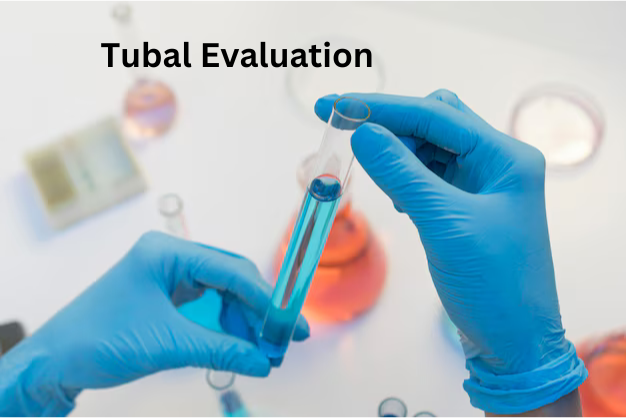Tubal Evaluation
Tubal evaluation is a crucial aspect of infertility diagnosis, helping to assess the condition of the fallopian tubes and the uterus. It plays a significant role in identifying various infertility factors, such as blocked or damaged fallopian tubes, endometriosis, and fibroids. Tubal factors contribute to infertility in approximately 35-40% of cases. At New World Fertility Centre, Delhi, we offer advanced and precise tubal evaluation procedures to help you achieve a successful pregnancy.
What is Tubal Evaluation?
Tubal evaluation is a diagnostic process used to assess the health and functionality of the fallopian tubes and the uterine cavity. The fallopian tubes are vital components of the female reproductive system, connecting the ovaries to the uterus. They are the site where ovulation, fertilization, and early embryo development occur. Any abnormalities in the fallopian tubes, such as blockages, damage, or the presence of conditions like endometriosis or fibroids, can lead to infertility, miscarriages, or pregnancy failure. Tubal evaluation helps identify these issues early on, enabling appropriate treatment to improve your chances of conception.
How Do Doctors Check Fallopian Tubes?
Modern medical technology offers several advanced, non-surgical and surgical techniques to evaluate the fallopian tubes. Some of the most commonly used methods include:
Hysterosalpingography (HSG): This is the most widely used technique for assessing fallopian tube patency and identifying any blockages or structural abnormalities. HSG involves injecting an iodinated contrast dye into the uterus and taking X-ray images to visualize the fallopian tubes and uterine cavity.
Saline Infusion Sonography (SIS): In this method, a saline solution is introduced into the uterine cavity through the cervix, and a transvaginal ultrasound is used to visualize the fallopian tubes. SIS is a cost-effective and reliable option for initial infertility evaluation.
Hystero-contrast Sonosalpingography (HyCoSy): HyCoSy is a newer technique that involves injecting an enhancing agent into the fallopian tubes and using a transvaginal ultrasound to assess tubal patency. It is a safe, less painful, and relatively inexpensive procedure that can be done during an outpatient visit.
Laparoscopy: Laparoscopy is a minimally invasive surgical procedure that provides a direct view of the fallopian tubes, uterus, and pelvic organs. It is often recommended when other tests indicate possible tubal occlusion or other pelvic abnormalities.
Hysterosalpingography (HSG) Tubal Evaluation:
Hysterosalpingography (HSG) is a well-established method for evaluating the fallopian tubes and identifying blockages or irregularities in the uterus. During the procedure, a special dye is injected into the uterus, and X-ray images are taken to visualize the fallopian tubes. HSG is a safe and affordable procedure that can significantly improve pregnancy rates by diagnosing issues that may be preventing conception.
Is HSG a Painful Procedure?
While HSG is generally well-tolerated, some patients may experience mild to moderate discomfort similar to menstrual cramps during the procedure. This discomfort is usually short-lived and can be managed with over-the-counter pain medication. The pain may occur during specific steps, such as the placement of the cervical tenaculum or the injection of dye, but it typically subsides quickly.
Saline Infusion Sonography (SIS) Tubal Evaluation:
Saline infusion sonography (SIS) is a procedure that uses transvaginal ultrasound and saline to evaluate the fallopian tubes. The saline solution helps visualize the tubes on ultrasound, allowing for the detection of abnormalities or blockages. SIS is a valuable tool for initial infertility workups, offering accurate results with minimal discomfort.
Hystero-contrast Sonosalpingography (HyCoSy) Tubal Evaluation:
HyCoSy is a newer technique that enhances the visualization of the fallopian tubes using a transvaginal ultrasound. After injecting an enhancing agent into the tubes, the ultrasound captures images that help determine whether the tubes are open or blocked. HyCoSy is a quick, safe, and less invasive procedure that can be performed during an outpatient visit.
Laparoscopy for Tubal Evaluation:
Laparoscopy is a surgical procedure used to diagnose and treat conditions affecting the fallopian tubes, such as blockages or endometriosis. It provides a direct view of the reproductive organs and is often recommended when other tests suggest possible tubal occlusion. Laparoscopy can also help treat any identified issues, improving the chances of a successful pregnancy.
Tubal Ligation Evaluation:
Tubal ligation is a surgical procedure that permanently prevents pregnancy by cutting or tying the fallopian tubes. If you have had a tubal ligation and wish to evaluate the success or possible complications, procedures like HSG, SIS, HyCoSy, and laparoscopy can be used to assess the condition of the tubes.
Can the Fallopian Tubes Be Seen on Ultrasound?
Fallopian tubes are typically not visible on ultrasound unless there is fluid within the tubal lumen or surrounding the tubes. When visualized with the help of saline or other enhancing agents, the fallopian tubes can be assessed for any abnormalities. However, due to the potential risks of dilation or thickening, experts often recommend other diagnostic methods for a more accurate evaluation.
Patency of Fallopian Tube Tests:
Hysterosalpingography (HSG) and hysterosalpingo-contrast sonography (HyCoSy) are the most common and reliable tests for evaluating tubal patency. These procedures allow doctors to visualize the fallopian tubes and determine whether they are open or blocked, which is essential for successful conception.
Types of Tubal Patency Tests:
Several tests are available to evaluate the patency of the fallopian tubes, depending on the patient's specific fertility conditions. These include:
- Hysterosalpingography (HSG)
- Radiologic selective cannulation of the fallopian tube
- Ultrasonography (SIS and HyCoSy)
- Hysteroscopy
- Tubal endoscopy
- Laparoscopy
- Laparotomy
Tubal Evaluation Costs:
The cost of tubal evaluation varies depending on the type of procedure, location, and additional services required. At New World Fertility Centre, Delhi, we offer affordable tubal evaluation services:
- Hysterosalpingography (HSG): Rs. 2000 to Rs. 3000
- Saline Infusion Sonography (SIS): Rs. 1000 to Rs. 2000
- Laparoscopy: Rs. 35,000 to Rs. 80,000
- Hystero-contrast Sonosalpingography (HyCoSy): Rs. 1000 to Rs. 2000
- Hysteroscopy: Starting from Rs. 15,000
- Tubal Endoscopy: Rs. 1000 to Rs. 3000
- Laparotomy: Rs. 45,000 to Rs. 65,000
Conclusion:
If you are facing infertility due to tubal factors or if your infertility cause is unknown, a thorough tubal evaluation is essential. The fallopian tubes are critical to reproductive success, facilitating the journey of the egg and sperm towards fertilization and implantation. Any complications in the tubes can hinder conception, making tubal evaluation a key strategy in identifying and correcting fertility issues.
At New World Fertility Centre, Delhi, we are committed to providing the best fertility care, including comprehensive tubal evaluation services. Contact us today to take the first step towards your journey to parenthood.
Frequently Asked Questions (FAQ)
1. What is Tubal Evaluation?
Tubal evaluation is a diagnostic procedure used to assess the condition of the fallopian tubes and uterine cavity. In the female reproductive system, the fallopian tubes connect the ovaries to the uterus, playing a crucial role in the process of conception. This channel is where ovulation, fertilization, and early embryo development occur. Tubal evaluation helps identify any blockages, damage, or abnormalities in the fallopian tubes that could contribute to infertility, recurrent miscarriages, or pregnancy failures in both natural conception and assisted reproductive techniques like IVF, ICSI, IUI, and surrogacy.
2. Why is Tubal Evaluation Important for Infertility Patients?
Tubal factor infertility accounts for approximately 35-40% of all infertility cases. Evaluating the fallopian tubes is essential because any abnormalities, such as blockages, damage, or conditions like endometriosis and fibroids, can prevent the sperm and egg from meeting, hinder fertilization, or affect the embryo's journey to the uterus. Identifying and addressing these issues early on can significantly improve the chances of a successful pregnancy.
3. How Do Doctors Check the Fallopian Tubes?
Doctors use several advanced techniques to evaluate the fallopian tubes, both non-surgical and surgical. The most common methods include:
- Hysterosalpingography (HSG): An X-ray procedure using a special dye to visualize the fallopian tubes and uterus.
- Saline Infusion Sonography (SIS): Ultrasound with saline infusion to assess the fallopian tubes.
- Hystero-contrast Sonosalpingography (HyCoSy): A transvaginal ultrasound with an enhancing agent to evaluate tubal patency.
- Laparoscopy: A surgical procedure that allows direct visualization of the fallopian tubes and pelvic organs.
4. What is Hysterosalpingography (HSG)?
Hysterosalpingography (HSG) is a commonly used method for evaluating fallopian tube patency and identifying blockages or abnormalities in the uterus. During the procedure, an iodinated contrast dye is injected into the uterus, and X-rays are taken to capture images of the uterine cavity and fallopian tubes. HSG is safe, relatively inexpensive, and helps identify issues that could prevent pregnancy.
5. Is HSG a Painful Procedure?
HSG is generally considered to cause minimal discomfort, though some women may experience mild to moderate pain, similar to menstrual cramps, during the procedure. The discomfort usually lasts only about 30 minutes and can be managed with over-the-counter pain medication. The most uncomfortable moments typically occur during the placement of the cervical tenaculum, dye injection, and tubal spilling.
6. What is Saline Infusion Sonography (SIS)?
Saline Infusion Sonography (SIS) is a procedure in which a saline solution is introduced into the uterus via a catheter. The saline allows the fallopian tubes to be visualized more clearly during a transvaginal ultrasound. SIS is useful for assessing the openness of the fallopian tubes and is a cost-effective, non-invasive option for initial infertility workups.
7. What is Hystero-contrast Sonosalpingography (HyCoSy)?
HyCoSy is a newer technique that evaluates the fallopian tubes using a transvaginal ultrasound before and after injecting an enhancing agent. If the agent flows freely through the tubes during scanning, it indicates that the tubes are open and functional. HyCoSy is safe, less painful, and relatively inexpensive, making it a popular choice for tubal evaluation.

 Aug-19-2025
Aug-19-2025